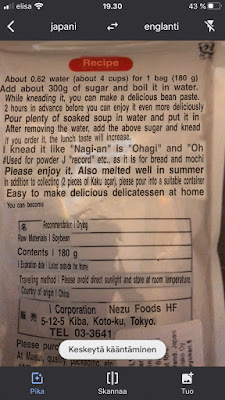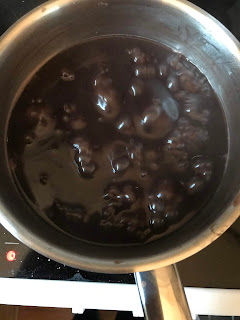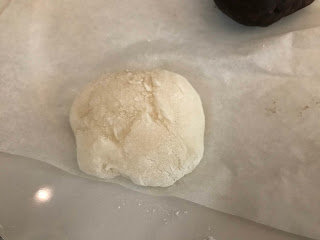The scene
Sachi is visiting the sisters' grand-aunt for some tea.The great-aunt is still a strong presence in the sisters' lives despite the sisters' grandmother having passed away a few years ago.
Great-aunt Fumiyo Kikuchi (played by Kirin Kiki).
She is worried about Suzu having moved in with the sisters and wonders if they know what they're doing. Raising a child is not an easy task, and, what's perhaps even more alarming, the daughter of a man who splintered the family before is now living in a house owned by the mother of said family. Sachi says it's alright because Suzu wasn't even born when it happened. The great-aunt worries this won't help the eldest sister find a husband for herself either.
The food
This needed a bit of research until I figured what exactly auntie is serving here. I think it's fair to assume they're having tea, but what on Earth are they eating?We get a couple of good looks at the treats. Here we see one in all its glory. It's reddish-brown, so I was thinking it would probably have something to do with anko, also known as red bean (or azuki bean) paste. Azuki bean paste is a common ingredient in Japanese desserts and treats, including my personal favourite, the solid red bean jelly yokan. But surely she wouldn't just be eating a huge lump of the stuff?
Ah, see? A moment later she's eaten most of it and now there's only some of the anko left... but there's something white as well. I wondered if it could be mochi, the famous Japanese delicacy made out of glutinous rice, but I wasn't sure because the red bean paste has always been inside the mochi I'd eaten. So - some research was necessary. Wonder what kind of local specialties they have in Kamakura, the city the movie takes place in?
Several Google searches later I landed on this article over on Live Japan. It is an itinerary for a day trip to Kamakura, and interestingly enough, the second item on the list is a visit to a shop called Chikaramochiya. In this shop you can buy something called gongoro chikaramochi which kind of looks and sounds like what they're having in the scene: mochi wrapped in anko!
Judging by the pictures for example here, it probably isn't the exact same item or at the very least hasn't been bought from Chikaramochiya. Perhaps the great-aunt made them herself, who knows (we can assume Sachi didn't make them because she says they look delicious). But now we know for sure that a Japanese treat that you might have in Kamakura is, indeed, mochi wrapped in azuki bean paste.
Recreating the food
Well, obviously I would need both anko and mochi for this, neither of which I had made before. I honestly thought about being lazy and just buying some mochi, but then I figured I wouldn't learn anything if I didn't at least give it a go. So, I set out to Tokyokan to find out if they had ingredients for both anko and mochi. They did, but unfortunately the glutinous rice bags were huge and the relatively small bag of azuki beans seemed incredibly expensive. There was, however, a bag of azuki bean powder which I decided to go with instead because it was more affordable and, and I also recalled seeing glutinous rice flour in other Asian stores in Helsinki, which I did indeed end up finding.
All told this seemed like a bit of a time-intensive operation, and having read somewhere that anko would keep in the fridge for a decent while, I decided I'd make anko first and then the mochi the following day.
Anko
There was a bit of a problem with the azuki bean powder. No one seems to have used the powder to make anko since all of the English-language recipes I found were made using the actual beans. Also...
Oh dear. The instructions are only in Japanese, and even though I'm currently learning Japanese, this kind of text is just too much to handle for me at this point. Thankfully, actual real-life magic has been invented - in the form of the camera function of the Google Translate app.
It's certainly not a perfect translation, but the basic idea seems pretty clear. Add the powder to 0.6 liters of water and throw in 300 g (dang, that's a lot) of sugar, boil and mix until it turns into a paste. There are further instructions that are more difficult to decipher but they also seem to be for other uses than the one I was going for. I also watched some videos to get an idea of the consistency I should be aiming for while boiling the stuff.
It took so long for the mixture to start thickening up that I was starting to think I must have misunderstood the Google Translated recipe somehow. However, after about 25 or 30 minutes it finally seemed like something was starting to happen. Thankfully I had anticipated it would take a while and was watching some garbage on YouTube on an iPad while stirring this weird deep brown and red soup.
A few more minutes later the mixture was definitely turning into a paste. As per the instructions of those videos I continued to boil the stuff for a while longer while mixing it constantly.
Finally, after about 50 minutes, my weird soup had indeed turned into a doughy paste! Boiling the paste seemed to be turning out diminishing returns with regards to the texture and since it seemed to be getting darker in color, I was worried about it burning if I kept boiling it, so I figured the paste was now done.
And what do you know, it tasted just like the anko I'd eaten before and even had the exact consistency I wanted after it had cooled for a moment! Only the colour seemed slightly darker than what I'd seen before, but it didn't taste burnt or bad, so I believe this was a success!
Mochi
The next day it was time to make mochi. I was honestly dreading this part because I felt like mochi should have a very specific, delicate consistency. Would I be able to achieve non-terrible results? Well, I would find out soon.
Many recipes start from the very beginning and use glutinous rice. I however had bought glutinous rice flour and thus had to find a recipe using that.
Many recipes start from the very beginning and use glutinous rice. I however had bought glutinous rice flour and thus had to find a recipe using that.
I got this glutinous rice flour from a Thai shop.
As luck would have it, one of my favorite websites, Just One Cookbook, had a daifuku recipe that used flour. Daifuku is a kind of mochi with some kind of filling such as anko, chocolate or perhaps ice cream. What I was making was sort of the inverse of daifuku, but the mochi is cooked the exact same way and I could just leave out the part where you spread the mochi thin with a rolling pin. I also happened to have corn starch in my kitchen.
Here I've mixed the rice flour, water and sugar. The next step was to set up the steamer which I wanted to try instead of the microwave oven, in large part because I happen to have a steam cooker pot.
I set up the the steamer with the mochi mixture in a bowl and wrapped the lid in a cloth as per the recipe on Just One Cookbook. I forgot to take a photo of the pot with the lid on, but the point is that the steam doesn't condense onto the lid and drip into the mochi mixture.
According to the recipe it takes 15 minutes of steaming for the mochi to cook. Halfway through you should stir the mixture. I was excited to find out that the stuff was indeed turning into something resembling mochi!
The mochi mass was done after another 7.5 minutes.
The next step was to get the mochi mass onto a parchment paper covered in corn starch to let it cool for a bit. This might've been the most difficult part of the entire operation since the glass bowl was of course steaming hot, as was the mochi itself. However, eventually I succeeded in getting the bowl out of the pot and the mass onto the parchment paper.
The recipe instructed to cover the mass with corn starch and then to brush off the excess starch with a pastry brush. I did so and let the still hot mass cool off for a moment. I had to have a small bite and was overjoyed to find out it tasted exactly like the mochi I had had before!
Not long after the mass had cooled down and I got to make the actual mochi balls. Since these mochi would just be going inside of the anko, I didn't bother with trying to make them look overly smooth - that's for daifuku and the like. I made eight of these small buns that were about 4 cm in diameter. Unfortunately I messed up the photo of all the mochi pieces, so here's one of them.
Gongoro chikaramochi
So - now I finally had both of the ingredients needed for the gongoro chikaramochi, and it was time to combine them!
I took some of the anko and tried to wrap one of the mochi in the stuff. It turned out that the anko was too crumbly taken straight out of the fridge, but I was eventually able to cover the mochi in the paste when it warmed a bit. I made four of them and then ate the rest of the mochi because I freaking love mochi.
A couple of my very own gongoro chikaramochi!
Trying it out
Here is my recreation of the moment Sachi shared with her great-aunt.
I made a cup of green tea to go along with the gongoro chikaramochi, like in the scene.
The treat itself looks and acts pretty much exactly like the stuff in the movie! Fantastic success!
Now, the taste. It's good, and its coolness works wonderfully with the hot tea! However, and I'm not sure if it's a problem with me boiling the anko for too long, the instructions calling for too much sugar (there was a LOT of it!) or both, but it was quite sugary and perhaps a bit dry. When you eat a normal anko-filled daifuku you mostly get mochi and the anko is there to give a bit of an extra flavour and texture. Here it's the other way around: it tastes mostly of the sugary anko and the milder mochi mostly just adds some texture to it. It's good, but I honestly can't say I prefer this particular version of mochi. However, making mochi was so easy and so much fun that I will most definitely be making some more in the future! I would love to try making chocolate or ice cream daifuku, and perhaps experiment with the mochi itself by adding matcha, cocoa or something else.
Recipes used
Mochi: Just One Cookbook
Anko:
























Comments
Post a Comment